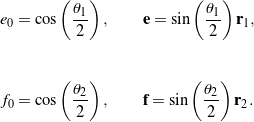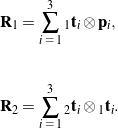In many applications, we are interested in dealing with compound rotations. For example, in biomechanics, studies of the knee joint feature the rotation of the femur relative to the tibia; in robotics, one often examines the rotation of a payload relative to an arm of the robot; and in celestial mechanics, one considers the rotation of the Moon relative to the Earth (which in turn is rotating about the Sun). For these instances, two quantities are of interest: the parameters (axis and angle) and angular velocity of the compound rotation. Here, we address these two topics using the work [1] of Olinde Rodrigues (1795–1851) from 1840 and a more recent work [2] by Casey and Lam in 1986.
Contents
Angle and axis of rotation of the compound rotation
Consider two rotation tensors ![]() and
and ![]() , and suppose that
, and suppose that
(1) 
That is, the angle and axis of rotation of ![]()
![]() are
are ![]() and
and ![]() . Rodrigues showed that
. Rodrigues showed that ![]() and
and ![]() could be represented in the following forms:
could be represented in the following forms:
(2) 
Here, ![]() and
and ![]() represent what are commonly referred to as a pair of sets of Euler parameters (or unit quaternions), where
represent what are commonly referred to as a pair of sets of Euler parameters (or unit quaternions), where
(3) 
The representations (2) follow from Euler’s representation for the pair of tensors by direct substitution of (3) and judicious use of trigonometric identities. Rodrigues then computed the composite rotation and showed directly that
(4) ![]()
where
(5) 
Thus, the angle of rotation ![]() and axis of rotation
and axis of rotation ![]() of the compound rotation
of the compound rotation ![]() are
are
(6) ![Rendered by QuickLaTeX.com \begin{eqnarray*} && \phi = 2 \cos^{-1}\left( g_0\right), \\ \\[0.10in] && {\bf r} = \mbox{cosec}\left(\frac{\phi}{2}\right){\bf g}. \end{eqnarray*}](https://rotations.berkeley.edu/wp-content/ql-cache/quicklatex.com-dd86954d66f0fcf669be770329f125bb_l3.png)
Although these results were first established by Rodrigues [1] in 1840, the earliest English commentary on them is by Cayley [3] in 1845. If you are familiar with quaternions, then you might recognize the similarity of (5) to Hamilton’s rules for quaternion multiplication from 1843. The reader is referred to Altmann [4, 5], Gray [6], and Pujol [7] for further historical details on this matter. We note that Pujol provides a detailed derivation of and useful commentary on Rodrigues’ formulae.
Angular velocity of the compound rotation
One approach to computing the angular velocity vector of a compound rotation ![]() is to use Rodrigues’ result (4) along with Euler’s representation
is to use Rodrigues’ result (4) along with Euler’s representation
(7) ![]()
for the angular velocity vector of a rotation in terms of a single rotation angle ![]() and rotation axis
and rotation axis ![]() . Such a calculation is very tedious. We instead follow Casey and Lam [2], who defined a very useful and intuitive relative angular velocity vector. To discuss the relative angular velocity vector, it is convenient to define three sets of right-handed orthonormal vectors:
. Such a calculation is very tedious. We instead follow Casey and Lam [2], who defined a very useful and intuitive relative angular velocity vector. To discuss the relative angular velocity vector, it is convenient to define three sets of right-handed orthonormal vectors: ![]() ,
, ![]() , and
, and ![]() , where we assume that
, where we assume that ![]()
![]() . For a given
. For a given ![]() and
and ![]() , two of these sets can be defined by use of the representations
, two of these sets can be defined by use of the representations
(8) 
Therefore, the compound rotation ![]() is such that
is such that
(9) ![]()
In words, the tensor ![]() transforms the vectors
transforms the vectors ![]() into the vectors
into the vectors ![]() . Now, following Casey and Lam [2], we consider the relative angular velocity tensor
. Now, following Casey and Lam [2], we consider the relative angular velocity tensor
(10) ![]()
Using the definition of the angular velocity tensors associated with ![]() and
and ![]() and the fact that
and the fact that ![]() , we substitute for
, we substitute for ![]() and
and ![]() in (10) to find that
in (10) to find that
(11) ![Rendered by QuickLaTeX.com \begin{eqnarray*} \hat{\bOmega}_{{\bf R}_2} = {\bOmega}_{\bf R} - {\bOmega}_{{\bf R}_1} \!\!\!\!\! &=& \!\!\!\!\! \dot{\bf R}{\bf R}^T - \dot{\bf R}_1{\bf R}^T_1 \\[0.075in] &=& \!\!\!\!\! \dot{\bf R}_2{\bf R}_1{\bf R}^T_1 {\bf R}^T_2 + {\bf R}_2\dot{\bf R}_1{\bf R}^T_1 {\bf R}^T_2 - \dot{\bf R}_1{\bf R}^T_1 \\[0.075in] &=& \!\!\!\!\! \dot{\bf R}_2{\bf R}^T_2 + {\bf R}_2{\bOmega}_{{\bf R}_1}{\bf R}^T_2 - {\bOmega}_{{\bf R}_1} \\[0.075in] &=& \!\!\!\!\! \dot{\bf R}_2{\bf R}^T_2 + {\bf R}_2{\bOmega}_{{\bf R}_1}{\bf R}^T_2 + {\bOmega}^T_{{\bf R}_1} \\[0.075in] &=& \!\!\!\!\! \left(\dot{\bf R}_2 + {\bf R}_2{\bOmega}_{{\bf R}_1} + {\bOmega}^T_{{\bf R}_1}{\bf R}_2 \right){\bf R}^T_2. \end{eqnarray*}](https://rotations.berkeley.edu/wp-content/ql-cache/quicklatex.com-4562865656b6c3afc93963c66e07a9de_l3.png)
However,
(12) ![]()
where the corotational derivative
(13) ![]()
for which ![]() . That is,
. That is, ![]() is the derivative of the tensor
is the derivative of the tensor ![]() assuming the vectors
assuming the vectors ![]() are constant. Consequently, the relative angular velocity tensor
are constant. Consequently, the relative angular velocity tensor
(14) ![]()
If we denote the axis of rotation of ![]() by
by ![]() and its angle of rotation by
and its angle of rotation by ![]() , then we can parallel the derivation of the result (7) for
, then we can parallel the derivation of the result (7) for ![]() to show that the relative angular velocity vector has the representation
to show that the relative angular velocity vector has the representation
(15) ![]()
where, for ![]() , the corotational derivative
, the corotational derivative ![]() . Equivalently,
. Equivalently,
(16) ![]()
Formula (15) proves to be exceedingly useful when calculating the angular velocity vector associated with various representations of a rotation tensor. In particular, for the Euler angle representation, we decompose ![]() into the product of three rotation tensors and then invoke (15) twice to obtain a representation for the corresponding angular velocity vector. The manner in which we do this is similar to the example we now discuss.
into the product of three rotation tensors and then invoke (15) twice to obtain a representation for the corresponding angular velocity vector. The manner in which we do this is similar to the example we now discuss.
An example
To illustrate the convenience of the relative angular velocity vector (15), suppose we consider the compound rotation ![]() , where
, where
(17) ![]()
The tensor ![]() defines a transformation consisting of a rotation through an angle
defines a transformation consisting of a rotation through an angle ![]() about
about ![]() . This rotation transforms
. This rotation transforms ![]()
![]() to
to ![]() :
:
(18) ![Rendered by QuickLaTeX.com \begin{eqnarray*} && {\bf t}_1 = \cos(\psi){\bf E}_1 + \sin(\psi){\bf E}_1, \\[0.15in] && {\bf t}_2 = - \sin(\psi){\bf E}_1 + \cos(\psi){\bf E}_2, \\[0.15in] && {\bf t}_3 = {\bf E}_3. \end{eqnarray*}](https://rotations.berkeley.edu/wp-content/ql-cache/quicklatex.com-7aa36b9311ea98aa040748ffeb370ca9_l3.png)
Thus, ![]() has the alternative representation
has the alternative representation
(19) ![]()
Note the change in notation when compared to (8)1: ![]() and
and ![]() are replaced with
are replaced with ![]() and
and ![]() , respectively. The relative rotation tensor
, respectively. The relative rotation tensor ![]() is chosen to correspond to a rotation through an angle
is chosen to correspond to a rotation through an angle ![]() about
about ![]() :
:
(20) ![Rendered by QuickLaTeX.com \begin{eqnarray*} {\bf R}_2 \!\!\!\!\! &=& \!\!\!\!\! \cos(\theta)({\bf I} - {\bf t}_2\otimes{\bf t}_2) - \sin(\theta) ( \bepsilon {\bf t}_2 ) + {\bf t}_2\otimes{\bf t}_2 \\[0.075in] &=& \!\!\!\!\! \cos(\theta)({\bf t}_1\otimes{\bf t}_1 + {\bf t}_3\otimes{\bf t}_3) - \sin(\theta)\left({\bf t}_3\otimes{\bf t}_1 - {\bf t}_1\otimes{\bf t}_3\right) + {\bf t}_2\otimes{\bf t}_2. \hspace{1in} \scalebox{0.001}{\textrm{\textcolor{white}{.}}} \end{eqnarray*}](https://rotations.berkeley.edu/wp-content/ql-cache/quicklatex.com-73f4c7bd7a9f161cc93c7c13218cc945_l3.png)
To calculate ![]() , we can employ (7) to find that
, we can employ (7) to find that
(21) ![Rendered by QuickLaTeX.com \begin{eqnarray*} {\bomega}_{{\bf R}_1} \!\!\!\!\! &=& \!\!\!\!\! \dot{\psi}{\bf E}_3 + \sin(\psi)\dot{\bf E}_3 + (1 - \cos(\psi)){\bf E}_3\times\dot{\bf E}_3 \\[0.075in] &=& \!\!\!\!\! \dot{\psi}{\bf E}_3. \end{eqnarray*}](https://rotations.berkeley.edu/wp-content/ql-cache/quicklatex.com-51a0b2f5dbf0c8633822d976f6820b13_l3.png)
However, we cannot appeal directly to (7) to determine ![]() because we have not calculated the rotation axis
because we have not calculated the rotation axis ![]() and rotation angle
and rotation angle ![]() of
of ![]() . Instead, we use the relative angular velocity vector
. Instead, we use the relative angular velocity vector ![]() . To do this, we first need to compute the corotational derivative of
. To do this, we first need to compute the corotational derivative of ![]() :
:
(22) ![]()
Hence, from (14),
(23) ![]()
and therefore, with the help of (16), we conclude that
(24) ![]()
Alternatively, we can arrive at (24) by using (15) directly. By replacing ![]() and
and ![]() in (15) with
in (15) with ![]() and
and ![]() , respectively, and then appealing to the fact that
, respectively, and then appealing to the fact that ![]() ,
,
(25) ![]()
This alternative approach is clearly equivalent to, but more attractive than, the method that involves calculating ![]() . Combining the expressions for
. Combining the expressions for ![]() and
and ![]() , we arrive at the angular velocity vector for
, we arrive at the angular velocity vector for ![]() :
:
(26) ![]()
The intuitive nature of this result is often surprising. Using (7), it is simple to see that ![]() :
:
(27) ![Rendered by QuickLaTeX.com \begin{eqnarray*} \bomega_{{\bf R}_2} \!\!\!\!\! &=& \!\!\!\!\! \dot{\theta}{\bf t}_2 + \sin(\theta)\dot{\bf t}_2 + \left( 1 - \cos(\theta)\right){\bf t}_2\times\dot{\bf t}_2 \\[0.075in] &=& \!\!\!\!\! \dot{\theta}{\bf t}_2 - \dot{\psi}\sin(\theta)\dot{\bf t}_1 + \dot{\psi}\left( 1 - \cos(\theta)\right){\bf t}_3 \\[0.075in] & \ne & \!\!\!\!\! \dot{\theta}{\bf t}_2 = \hat{\bomega}_{{\bf R}_2}, \end{eqnarray*}](https://rotations.berkeley.edu/wp-content/ql-cache/quicklatex.com-a13866fbe02b1c37b54dce27a0a2e9f4_l3.png)
where we used the result that ![]() . The distinction between the angular velocity vectors
. The distinction between the angular velocity vectors ![]() and
and ![]() can be attributed to the fact that
can be attributed to the fact that ![]() is computed assuming the rotation axis
is computed assuming the rotation axis ![]() is fixed, which is not the case when calculating
is fixed, which is not the case when calculating ![]() .
.
References
- Rodrigues, O., Des lois géométriques qui régissent les déplacemens d’un système solide dans l’espace, et de la variation des coordonnées provenant de ses déplacements consideérés indépendamment des causes qui peuvent les produire, Journal des Mathématique Pures et Appliquées 5 380–440 (1840).
- Casey, J., and Lam, V. C., On the relative angular velocity tensor, ASME Journal of Mechanisms, Transmissions, and Automation in Design 108(3) 399–400 (1986).
- Cayley, A., On certain results relating to quaternions, Philosophical Magazine 26 141–145 (1845). Reprinted in pp. 123–126 of The Collected Mathematical Papers of Arthur Cayley, Sc.D., F.R.S., Vol. 1, Cambridge University Press, Cambridge (1889).
- Altmann, S. L., Rotations, Quaternions, and Double Groups, Oxford University Press, New York (1986). Reprinted by Dover Publications in 2005.
- Altmann, S. L., Hamilton, Rodrigues, and the quaternion scandal, Mathematics Magazine 62(5) 291–308 (1989).
- Gray, J. J., Olinde Rodrigues’ paper of 1840 on transformation groups, Archive for History of Exact Sciences 21(4) 375–385 (1980).
- Pujol, J., The Rodrigues equations for the composition of finite rotations: A simple ab initio derivation and some consequences, ASME Applied Mechanics Reviews 65(5) 054501 (2013).